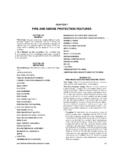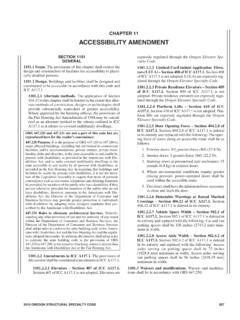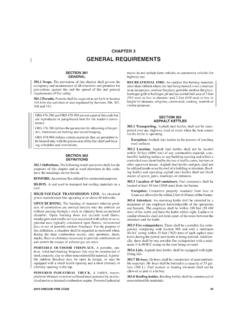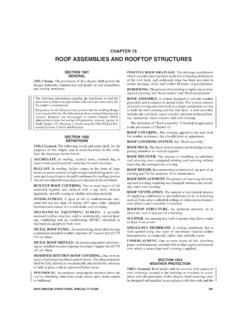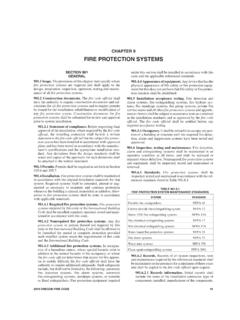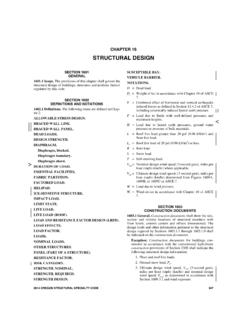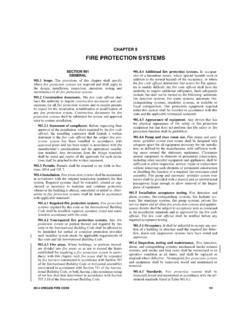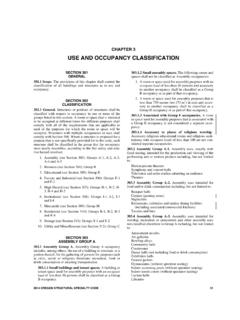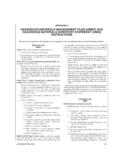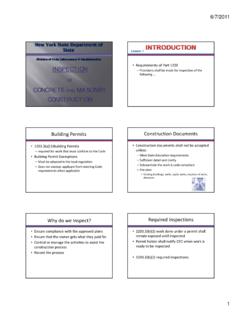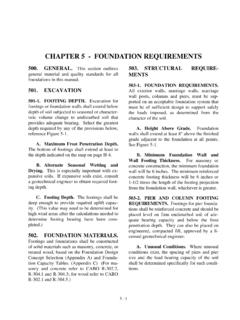Transcription of CHAPTER 18 SOILS AND FOUNDATIONS - eCodes
1 CHAPTER 18 SOILS AND FOUNDATIONSThis CHAPTER has been revised in its entirety; there will be no marginal provisions of this CHAPTER shall apply tobuilding and foundation Design bearing pressures, allowablestresses and design formulas provided in this CHAPTER shall beused with theallowable stress designload combinations speci-fied in Section The quality and design of materials usedstructurally in excavations and FOUNDATIONS shall comply withthe requirements specified in Chapters 16, 19, 21, 22 and 23 ofthis code. Excavations and fills shall also comply with following words and terms shall,for the purposes of this CHAPTER , have the meanings deep foundation is a foundationelement that does not satisfy the definition of a shallow drilled shaft is a cast-in-place deepfoundation element constructed by drilling a hole (with orwithout permanent casing)
2 Into soil or rock and filling it withfluid drilled socketed drilled shaft is a drilledshaft with a permanent pipe or tube casing that extendsdown to bedrock and an uncased socket drilled into the steel deep foundation ele-ment consisting of a central shaft and one or more helical bear-ing plates. A helical pile is installed by rotating it into theground. Each helical bearing plate is formed into a screw threadwith a uniform defined micropile is a bored, grouted-in-place deepfoundation element that develops its load-carrying capacity bymeans of a bond zone in soil , bedrock or a combination of soiland shallow foundation is anindividual or strip footing, a mat foundation.
3 A slab-on-gradefoundation or a similar foundation 1803 GEOTECHNICAL investigations shall be con-ducted in accordance with Section and reported inaccordance with Section Where required by thebuild-ing officialor where geotechnical investigations involve in-situtesting, laboratory testing or engineering calculations, suchinvestigations shall be conducted by aregistered design Investigations investigationsshall be conducted in accordance with Sections :Thebuilding officialshall be permitted to waivethe requirement for a geotechnical investigation where sat-isfactory data from adjacent areas is available that demon-strates an investigation is not necessary for any of theconditions in Sections through and Sec-tions and sites for new structures and facilities definedby ORS as essential facilities, hazardous facili-ties, major structures [parking structures are classified asmajor structures when they are over three stories and30,000 square feet (2787m2)]
4 Of aggregate floor area] andspecial occupancy structures shall be evaluated on thesite-specific basis for vulnerability to seismic geologichazards. This evaluation shall be done by an especiallyqualified engineer or engineering geologist registered bythe state to practice as such. Such an evaluation and reportmay require the services of persons especially qualified infields of engineering seismology, earthquake geology orgeotechnical Tsunami inundation new essen-tial facilities and some new special occupancy struc-tures as defined in ORS shall not be constructedin tsunami inundation zones established by the Depart-ment of Geology and Mineral Industries (DOGAMI),unless specifically exempted by ORS or given anexception by the DOGAMI governing board.
5 See OARC hapter 632, Division 5, adopted by DOGAMI for spe-cific provisions. Some other new essential facilities, other special occupancy structures and all new haz-ardous facilities and major structures defined in that are constructed in a tsunami inundation zoneare mandated to seek advice from DOGAMI, but are notnecessarily prohibited from tsunami inundation OAR CHAPTER 632, Division 5, adopted by DOGAMIfor specific provisions. See Table for a summaryof statute OREGON STRUCTURAL SPECIALTY CODE427 The Oregon Department of Geology and Mineral Industries,800 NE Oregon Street, Suite 965, Portland, OR (971) 673-1555.
6 Fax (971) :\data\CODES\STATE CODES\Oregon\2010\Structural Specialty_Building\Final VP\ , January 08, 2010 12:36:24 PMColor profile: Generic CMYK printer profileComposite Default screen4282010 OREGON STRUCTURAL SPECIALTY CODESOILS AND FOUNDATIONSORS not part of this code but is reproduced here for thereader s Construction of certain facilities and structures in tsu-nami inundation zone prohibited; establishment of zone; rules;exceptions.(1)(a) New essential facilities described in ORS (1)(a)(A),(B) and (G) and new special occupancy structures described inORS (1)(e)(B), (C) and (E) shall not be constructed in tsu-nami inundation zone established under paragraph (c) of this sub-section.
7 The provisions of this paragraph apply to buildings with acapacity greater than 50 individuals for every public, private orparochial school through secondary level and child care centers.(b) The State Department of Geology and Mineral Industriesshall establish the parameters of the area of expected tsunamiinundation based on scientific evidence that may include geo-logic field data and tsunami modeling.(c) The governing board of the State Department of Geology andMineral Industries, by rule, shall determine the tsunami inunda-tion zone based on the parameters established by the board shall adopt the zone as determined by the departmentunder paragraph (9b) of this subsection except as modified by theboard under paragraph (d) of this subsection.
8 (d) The board may grant exceptions to restrictions in the tsunamiinundation zone established under paragraph (c) of this subsec-tion after public hearing and a determination by the board that theapplicant has demonstrated that the safety of building occupantswill be ensured to the maximum reasonable extent:(A) By addressing the relative risks within the zone.(B) By balancing competing interests and other considerations.(C) By considering mitigative construction strategies.(D) By considering mitigative terrain modifications.(e) The provisions of paragraph (a) of this subsection do not apply:(A) To fire or police stations where there is a need for strategiclocation; and(B) To public schools if there is a need for the school to bewithin the boundaries of a school district and this cannot oth-erwise be accomplished.
9 (f) All materials supporting an application for an exception to thetsunami inundation zone are public records under ORS and shall be retained in the library of the departmentfor periods of time determined by its governing board.(g) The applicant for an exception to the tsunami inundation zoneestablished under paragraph (c) of this subsection shall pay anycosts for department review of the application and the costs, ifany, of the approval process.(2) The definitions in ORS apply to this section.(3) The provisions of this section do not apply to water-dependentand water-related facilities, including but not limited to docks,wharves, piers and marinas.
10 (4) Decisions made under this section are not land use decisionsunder ORS (10).Definitions from ORS (1) are not part of this code but arereproduced here for the reader s Regulation of certain structures vulnerable to earth-quakes and tsunamis; rules.(1) As used in this section, unless the context requires otherwise:(a) Essential facility means:(A) Hospitals and other medical facilities having surgery andemergency treatment areas;(B) Fire and police stations;(C) Tanks or other structures containing, housing or support-ing water or fire-suppression materials or equipment requiredfor the protection of essential or hazardous facilities or specialoccupancy structures;(D) Emergency vehicle shelters and garages;(E) Structures and equipment in emergency-preparednesscenters.
